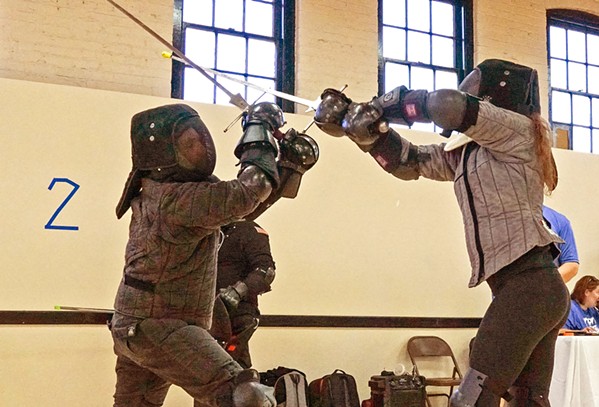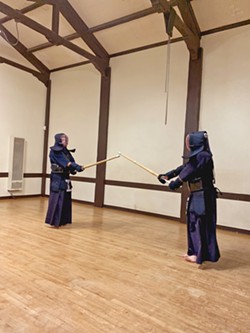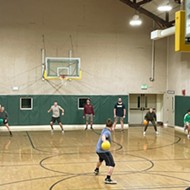[{
"name": "Ad - Medium Rectangle CC01 - 300x250",
"id": "AdMediumRectangleCC01300x250",
"class": "inlineCenter",
"insertPoint": "8",
"component": "2963441",
"requiredCountToDisplay": "12"
},{
"name": "Ad - Medium Rectangle LC01 - 300x250",
"id": "AdMediumRectangleCC01300x250",
"class": "inlineCenter",
"insertPoint": "18",
"component": "2963441",
"requiredCountToDisplay": "22"
},{
"name": "Ad - Medium Rectangle LC09 - 300x250",
"id": "AdMediumRectangleLC09300x250",
"class": "inlineCenter",
"insertPoint": "28",
"component": "3252660",
"requiredCountToDisplay": "32"
}]
Baseball, football, soccer, volleyball, tennis—the list is long when it comes to commonplace recreational sports. But when your body doesn't move like it used to, set your sights upon a unique, sharper form of exercise: sword fighting.
At Central Coast Aikido Kendo, head instructor Jason Carter breaks down the intricacies of the Japanese sport.
"It's beating other people with sticks—it's awesome. And, it's totally legal," Carter said with a laugh. "By participant count, it's the most popular martial art in Japan, more people do Kendo than all other martial arts combined."
Carter explained that Japanese samurai developed Kendo as a way to practice sword fighting without using real steel swords, which in turn evolved into its own martial art by the 1800s. Today, participants wield bamboo swords while decked out in armor that Carter jokingly described as "Darth Vader, but without the cape."
Although Carter fenced in college, he discovered Kendo in his early 20s while he was living in Japan.
"I did a lot of Western sports, like mountain biking, road biking, fencing, cross country in college and high school. A lot of the athletes in what I was doing were hitting their peak in their [early 20s]," Carter said. "But a lot of the greatest guys in Kendo were in their 30s, 40s, and 50s. So it had a much longer participant life expectancy."
When Carter moved to the Central Coast, he realized that there were no other Kendo dojos in the area, prompting him to open up his own dojo, Central Coast Aikido Kendo.
"There's a long history of Kendo on the Central Coast because it was introduced by the first generation of Japanese farmers that lived in SLO all the way down to Lompoc," Carter explained. "They had Kendo dojos in the late 1800s and early 1900s, but most of those were wiped out with the internment of Japanese people during WWII. Most of those Kendo dojos never rebooted."
He began teaching Kendo in Paso Robles in 2004 before eventually expanding to SLO, Lompoc, Santa Maria, and Vandenberg.
Before rushing to sign up for a class, people should think about what they want out of the sport, Carter said. Unlike Western forms of swordplay like fencing, Carter says that Kendo goes beyond just competition—it's a way of life.
"You have to come at it with a patient attitude because it's something you're set to do for the whole length of your life, and mastery does not come quickly," Carter said. "If it's something you want to have fun at and do it quickly and be very casual at, then that's a different sport."
Class prices vary depending on the location—in Lompoc and Santa Maria, classes can cost anywhere from $30 to $35 a month. Advanced Kendo classes take place for free at the San Luis Obispo Buddhist Temple, although Carter recommends donating money to the temple.
For more sword than stick, at Blackfriar's School of Fence history buffs and self-proclaimed nerds like Jenna Johnson can put their historical fantasy knowledge to the test.
"We're really just a group of friends that just get together," Johnson said. "We're all a bunch of nerds who like fantasy, historical stuff, that sort of thing, and we enjoy the sport of sword fighting and learning the history of it."
Blackfriar's exclusively specializes in European martial arts, learning how to fight with weapons like the longsword, saber, dagger, and more. These fighting techniques are derived from ancient manuscripts, which can now be readily accessed online, namely through the Historical European Martial Arts, aka HEMA.
"We're going back in time, in a sense, and we're learning from the original manuscripts and trying to reinvent the wheel," Johnson said. "The original people who started out getting into this sport had to kind of figure things out. People are still looking at stuff and trying to figure out exactly how to move for these different guards."
However, don't expect to start sparring with steel swords right off the bat. Wooden swords hurt plenty if you push hard enough, Johnson explained. Once you get the fundamentals down, students graduate to using a more solid, synthetic sword—one that has a metal grip with what Johnson calls a "nylon plastic" blade.
"And those are good because they have a little bit of flex. Once you become good at that, you graduate to steel," Johnson said. "The only way you can really let people start picking up steel is if they're fully kitted out. They have all the gear because we don't want anyone to get hurt."
And it takes quite a bit of strength to wield these swords. Johnson describes sword fighting as akin to a full-body workout.
"But you have to kind of think ahead so you've got your mind engaged. You have to be fast, you have to react. So your arms are being used a lot," Johnson said. "Your legs, the power comes from your legs. The fact that we're moving in a circular motion, so there's kind of pivoting."
For partakers of the sport like Veronica Heilman, the satisfaction of being able defend herself against an opponent makes fighting with a longsword appealing.
"There's a lot of adrenaline in it. When somebody has [what's] not a real sword but it's still a stick coming out real fast, it gets the adrenaline pumping, and it feels really good to be able to defend yourself from something like that," Heilman said.
Johnson said that sword fighting is perfect for those who feel nervous about high performance sports.
"The nice thing about HEMA is that, in my experience, it has been a wonderful environment to be in if you want to do something athletic but you're worried about being judged or worried about not being good enough or worried about being able to fit in and do it," Johnson said.
But those with a competitive streak can opt to participate in competitions, such as the upcoming tournament, SoCal Swordfight 2023.
"A handful of us are competitors," Johnson said. "But there are quite a few of us who are brand new, who are just learning, or just there to hang out and to have fun. So kind of a mix."
If you need more convincing to take a class at Blackfriar's School of Fence, allow Heilman to provide a compelling reason to sign up.
"Why sword fighting? Because if you say you're a basketball player, yeah, that's pretty cool," Heilman said. "You go to a bar and you tell a guy or a gal that, 'I know how to sword fight. I'm a swordswoman. I have a sword at home.' That's a good thing on your dating résumé."
Contact Staff Writer Shwetha Sundarrajan at [email protected].
Latest in News
Readers also liked…
-

Coast Unified teachers upset over new position's salary and qualifications
Oct 20, 2022 -

SLO police identify alleged driver who hit and killed couple
Dec 22, 2022 -

When the levee breaks: Oceano residents, county officials walk a tightrope of regulations to manage Arroyo Grande Creek, which some say led to the levee's failure in January
May 18, 2023















